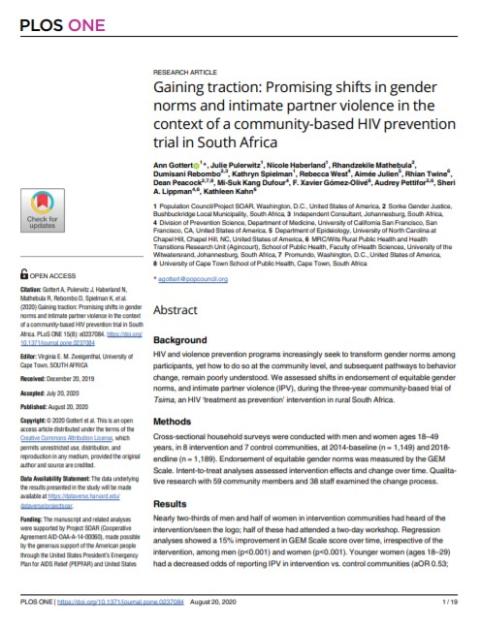- Journal article
- 20 August 2020
Gaining traction: Promising shifts in gender norms and intimate partner violence in the context of a community-based HIV prevention trial in South Africa
- Author: Ann Gottert, Julie Pulerwitz, Nicole Haberland, Rhandzekile Mathebula, Dumisani Rebombo, Kathryn Spielman, Rebecca West, Aimée Julien, Rhian Twine, Dean Peacock, Mi-Suk Kang Dufour, F. Xavier Gómez-Olivé, Audrey Pettifor, Sheri A. Lippman, Kathleen Kahn
- Published by: PLOS one

Abstract
Background
HIV and violence prevention programs increasingly seek to transform gender norms among participants, yet how to do so at the community level, and subsequent pathways to behavior change, remain poorly understood. We assessed shifts in endorsement of equitable gender norms, and intimate partner violence (IPV), during the three-year community-based trial of Tsima, an HIV ‘treatment as prevention’ intervention in rural South Africa.
Methods
Cross-sectional household surveys were conducted with men and women ages 18–49 years, in 8 intervention and 7 control communities, at 2014-baseline (n = 1,149) and 2018-endline (n = 1,189). Endorsement of equitable gender norms was measured by the GEM Scale. Intent-to-treat analyses assessed intervention effects and change over time. Qualitative research with 59 community members and 38 staff examined the change process.
Results
Nearly two-thirds of men and half of women in intervention communities had heard of the intervention/seen the logo; half of these had attended a two-day workshop. Regression analyses showed a 15% improvement in GEM Scale score over time, irrespective of the intervention, among men (p<0.001) and women (p<0.001). Younger women (ages 18–29) had a decreased odds of reporting IPV in intervention vs. control communities (aOR 0.53; p<0.05). Qualitative data suggest that gender norms shifts may be linked to increased media access (via satellite TV/smartphones) and consequent exposure to serial dramas modeling equitable relationships and negatively portraying violence. Tsima’s couple communication/conflict resolution skills-building activities, eagerly received by intervention participants, appear to have further supported IPV reductions.
Conclusions
There was a population-level shift towards greater endorsement of equitable gender norms between 2014–2018, potentially linked with rapid escalation in media access. There was also an intervention effect on reported IPV among young women, likely owing to improved couple communication. Societal-level gender norm shifts may create enabling environments for interventions to find new traction for violence and HIV-related behavior change.
- Countries / Regions:
- South Africa
Related resources
Blog
19 December 2024

Blog
5 December 2024

Report
30 September 2024
